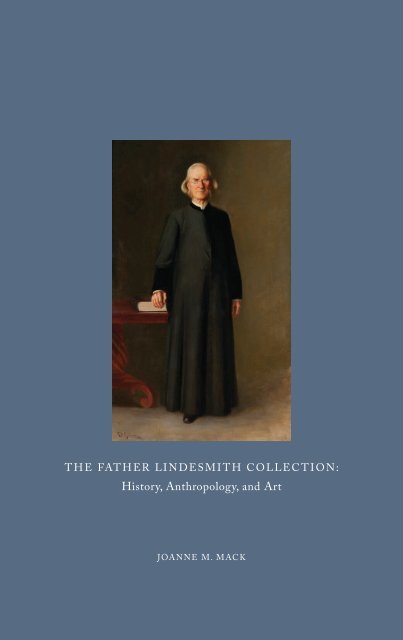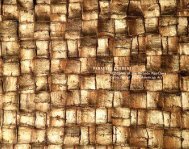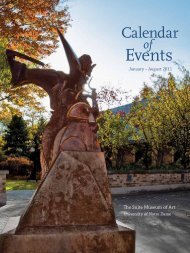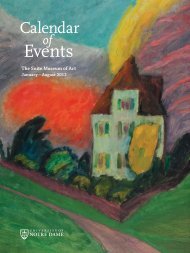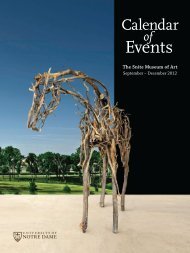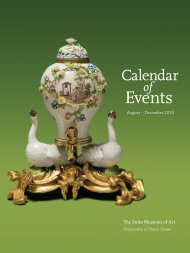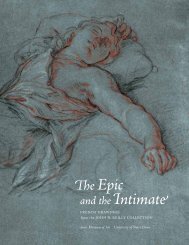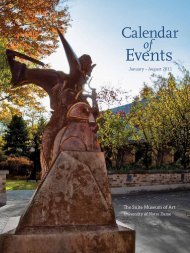HISTORY INTO ART AND ANTHROPOLOGY - Snite Museum of Art ...
HISTORY INTO ART AND ANTHROPOLOGY - Snite Museum of Art ...
HISTORY INTO ART AND ANTHROPOLOGY - Snite Museum of Art ...
You also want an ePaper? Increase the reach of your titles
YUMPU automatically turns print PDFs into web optimized ePapers that Google loves.
THE FATHER LINDESMITH COLLECTION:<br />
History, Anthropology, and <strong>Art</strong><br />
JOANNE M. MACK<br />
<strong>Museum</strong> collections are built, in part, upon personal collections that have been<br />
donated by the individuals who assembled them. Such donations <strong>of</strong>ten help shape<br />
a museum’s exhibitions. Often lacking actual accounts and records, curators and<br />
art historians can only imagine most collectors’ motives and the circumstances<br />
surrounding the acquisition <strong>of</strong> objects that so intrigued them. Fortunately, there is no<br />
need for such speculation or conjecture in the case <strong>of</strong> Father Eli John Washington<br />
Lindesmith, whose voluminous records have all been archived. These include account<br />
books detailing most <strong>of</strong> the items in his collection, his diaries, memoirs, letters (both<br />
sent and received), lectures, sermons, photographs, and perhaps most important<br />
<strong>of</strong> all, descriptive tags for every object and notes for every photograph, which he<br />
attached to each item when he donated it.<br />
In a March 1911 letter to Pr<strong>of</strong>essor Henry Hyvernat <strong>of</strong> the Catholic University<br />
<strong>of</strong> America in Washington, D.C., Father Lindesmith wrote that he had displayed<br />
objects he obtained while serving as chaplain at Fort Keogh in Montana Territory,<br />
but came to realize, after sending them to Ohio, that he could not care for them<br />
properly. “I shipped my entire collection to Dungannon, Columbianna [sic] County,<br />
Ohio,” he explained, “and placed it all in a large school room <strong>of</strong> St. Phillip’s church;<br />
where the bishop stationed me as a pastor. People came from far and wide to see<br />
the curiosities. I soon found I could not attend to it.” 1 In a letter to Pr<strong>of</strong>essor J. H.<br />
Edwards at the University <strong>of</strong> Notre Dame a dozen years earlier, he had asserted<br />
that although the items were then not worth much, they would have great value a<br />
hundred years hence. 2<br />
Father Lindesmith correctly anticipated that his collection would someday be<br />
respected for its historical relevance. By affixing an explanatory label to each item,<br />
this foresighted collector was shedding light on aspects <strong>of</strong> America’s past. Because<br />
he hoped future generations would learn from his holdings, he decided to donate<br />
them to several Catholic educational institutions.<br />
Lindesmith began dividing and disseminating the collection by giving about half <strong>of</strong> it<br />
to the Catholic University <strong>of</strong> America in 1898; he probably had visited the school in<br />
1888, not long after its founding. 3 In 1899 he donated approximately one-quarter <strong>of</strong><br />
his collection, including a recently painted full-length portrait <strong>of</strong> himself (opposite),<br />
to the University <strong>of</strong> Notre Dame. 4 His diaries and memoirs note several visits to the<br />
university. During one, in 1891, he was impressed by the campus post <strong>of</strong> the Grand<br />
Army <strong>of</strong> the Republic, composed <strong>of</strong> faculty members. 5 Furthermore, he knew <strong>of</strong> the<br />
Catholic Historical Collection in the Bishops’ <strong>Museum</strong> at the university because he<br />
had donated a vestment to that collection in 1894. 6<br />
27


